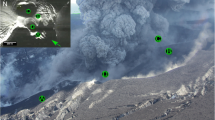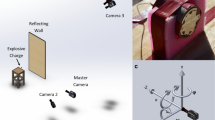Abstract
Reconstructing bomb trajectories resulting from Strombolian activity can provide insights into near-surface dynamics of the conduit system. Typically, the high number of bombs involved represents a challenge for both automatic and manual bomb identification and tracking methods. Here, we present a method for the automated recognition of hundreds of bombs (100 to 400 depending on the explosion observed) and for the reconstruction of their trajectories in time and 3D space by stereophotogrammetry. The data involve video collected at 30 Hz with two synchronised cameras (Basler 1300-30), separated by 11°, targeting explosions at Stromboli (Aeolian Islands, Italy) in September–October 2012. In total, six data sets were collected for emissions lasting less than 15 s. The 3D reconstructions provided more accurate velocity estimations (error < 10%) than 2D analyses (errors up to 90–100% for bombs moving parallel to the line of sight of the camera). By coupling the measured trajectories with a numerical ballistic model, we show that the method can be used to estimate the directional distribution of bombs and their velocities at the vent (which in this case was 30–130 m s−1), the wind velocity (~ 3.5 m s−1 from the NW) and the drag coefficients (10−3.5 − 10−0.5) of the bombs. The 3D reconstructions also provide a quantification of the directions of explosions and show that explosions can be radial, oriented in a predominant direction of ejection or in several directions; these dispersion patterns can change during a few seconds in a single explosion. We relate the changing directions of ejections to rheological variations in the upper part of the magmatic system probably filled with a mixture of partially crystallised magma which can direct rising slugs along preferential paths.











Similar content being viewed by others
References
Alatorre-Ibargüengoitia MA, Delgado-Granados H (2006) Experimental determination of drag coefficient for volcanic materials: calibration and application of a model to Popocatépetl volcano (Mexico) ballistic projectiles. Geophys Res Lett 33:11. https://doi.org/10.1029/2006GL026195
Alatorre-Ibargüengoitia MA, Delgado-Granados H, Dingwell DB (2012) Hazard map for volcanic ballistic impacts at Popocatépetl volcano (Mexico). Bull Volcanol 74:2155–2169. https://doi.org/10.1007/s00445-012-0657-2
Bai L, Baker DR, Polacci M, Hill RJ (2011) In-situ degassing study on crystal-bearing Stromboli basaltic magmas: implications for Stromboli explosions. Geophys Res Lett 38:L17309. https://doi.org/10.1029/2011GL048540
Bombrun M, Barra V, Harris A (2014) Algorithm for particle detection and parameterization in high-frame-rate thermal video. J Appl Remote Sens 8(1):083549. https://doi.org/10.1117/1.JRS.8.083549
Bombrun M, Harris AJL, Gurioli L, Battaglia J, Barra V (2015) Anatomy of a Strombolian eruption: inferences from particle data recorded with thermal video. J Geophys Res Solid Earth 120:2367–2387. https://doi.org/10.1002/2014JB011556
Brown DC (1966) Decentering distortion of lenses. Photogramm Eng 32(3):444–462
Burton MR, Mader HM, Polacci M (2007) The role of gas percolation in quiescent degassing of persistently active basaltic volcanoes. Earth Planet Sci Lett 264:46–60. https://doi.org/10.1016/j.epsl.2007.08.028
Capponi A, Taddeucci J, Scarlato P, Palladino DM (2016) Recycled ejecta modulating Strombolian explosions. Bull Volcanol 78:13. https://doi.org/10.1007/s00445-016-1001-z
Chevalier L, Donnadieu F (2015) Considerations on ejection velocity estimation from infrared radiometer data: a case study at Stromboli volcano. J Volcanol Geotherm Res 302:130–140. https://doi.org/10.1016/j.jvolgeores.2015.06.022
Chouet B, Hamisevicz N, McGetchin TR (1974) Photoballistics of volcanic jet activity at Stromboli, Italy. J Geophys Res 79(32):4961–4976. https://doi.org/10.1029/JB079i032p04961
Chouet B, Saccorotti G, Martini M, Dawson P, De Luca G, Milana G, Scarpa R (1997) Source and path effects in the wave fields of tremor and explosions at Stromboli Volcano, Italy. J Geophys Res 102(B7):15129–15150. https://doi.org/10.1029/97JB00953
Chouet B, Dawson P, Martini M (2008a) Upper conduit structure and explosion dynamics at Stromboli. In: Calvari S, Inguaggiato S, Puglisi G, Ripepe M, Rosi M (eds) The Stromboli volcano: an integrated study of the 2002–2003 eruption. AGU, Washington, pp 81–92. https://doi.org/10.1029/182GM08
Chouet B, Dawson P, Martini M (2008b) Shallow-conduit dynamics at Stromboli Volcano, Italy, imaged from waveform inversions. In: Lane SJ, Gilbert JS (eds) Fluid motions in volcanic conduits: a source of seismic and acoustic signals, Vol. 307 of Geol. Soc. Spec. Publ. The Geological Society, pp 57–84. https://doi.org/10.1144/SP307.5
Crocker JC, Grier DG (1996) Methods of digital video microscopy for colloidal studies. J Colloid Interface Sci 179:298. https://doi.org/10.1006/jcis.1996.0217
de’Michieli Vitturi M, Neri A, Esposti Ongaro T, Lo Savio S, Boschi E (2010) Lagrangian modeling of large volcanic particles: application to Vulcanian explosions. J Geophys Res Solid Earth 115:B8. https://doi.org/10.1029/2009JB007111
Diefenbach AK, Crider JG, Schilling SP, Dzurizin D (2012) Rapid, low-cost photogrammetry to monitor volcanic eruptions: an example from Mount St. Helens, Washington, USA. Bull Volcanol 74:–579. https://doi.org/10.1007/s00445-011-0548-y
Eiken T, Sund M (2012) Photogrammetric methods applied to Svalbard glaciers: accuracies and challenges. Polar Res 31:18671. https://doi.org/10.3402/polar.v31i0.18671
Eltner A, Kaiser A, Abellan A, Schindewolf M (2017) Time lapse structure from motion photogrammetry for continuous geomorphic monitoring. Earth Surf Process Landforms 42(14):2240–2253. https://doi.org/10.1002/esp.4178
Favalli M, Fornaciai A, Pareschi MT (2009) LIDAR strip adjustment: application to volcanic areas. Geomorphology 111:123–135. https://doi.org/10.1016/j.geomorph.2009.04.010
Formenti Y, Druitt TH, Kelfoun K (2003) Characterisation of the 1997 Vulcanian explosions of Soufrière Hills volcano, Montserrat, by video analysis. Bull Volcanol 65(8):587–605. https://doi.org/10.1007/s00445-003-0288-8
Gaudin D, Moroni M, Taddeucci J, Scarlato P (2014) Pyroclast tracking velocimetry: a particle tracking velocimetry-based tool for the study of Strombolian explosive eruptions. J Geophys Res Solid Earth 119(7):5369–5383. https://doi.org/10.1002/2014JB011095
Gaudin D, Taddeucci J, Houghton BF, Orr TR, Andronico D, Del Bello E, Kueppers U, Ricci T, Scarlato P (2016) 3-D high-speed imaging of volcanic bomb trajectory in basaltic explosive. Geochem Geophys Geosyst 17(10):4268–4275. https://doi.org/10.1002/2016GC006560
Gaudin D, Taddeucci J, Scarlato P, del Bello E, Ricci T, Orr T, Houghton B, Harris A, Rao S, Bucci A (2017) Integrating puffing and explosions in a general scheme for Strombolian-style activity. J. Geophys. Res. Solid Earth 122:1860–1875. https://doi.org/10.1002/2016JB013707
Gouhier M, Donnadieu F (2008) Mass estimations of ejecta from Strombolian explosions by inversion of Doppler-radar measurements. J Geophys Res 113:B10202. https://doi.org/10.1029/2007JB005383
Granshaw SI (1980) Bundle adjustment methods in engineering photogrammetry. Photogramm Rec 10(56):181–207. https://doi.org/10.1111/j.1477-9730.1980.tb00020.x
Granshaw SI (2016) Photogrammetric terminology. Photogramm Rec 31(154):210–252. https://doi.org/10.1111/phor.12146
Gurioli L, Harris AJL, Colò L, Bernard J, Favalli M, Ripepe M, Andronico D (2013) Classification, landing distribution, and associated flight parameters for a bomb field emplaced during a single major explosion at Stromboli, Italy. Geology 41(5):559–562. https://doi.org/10.1130/G33967.1
Gurioli L, Colò L, Bollasina AJ, Harris AJL, Whittington A, Ripepe M (2014) Dynamics of Strombolian explosions: inferences from field and laboratory studies of erupted bombs from Stromboli volcano. J Geophys Res Solid Earth 119:319–345. https://doi.org/10.1002/2013JB010355
Harris AJL, Ripepe M (2007) Synergy of multiple geophysical approaches to unravel explosive eruption conduit and source dynamics−a case study from Stromboli. Geochem 67:1–35. https://doi.org/10.1016/j.chemer.2007.01.003
Harris AJL, Ripepe M, Calvari S, Lodato L, Spampinato L (2008) The 5 April 2003 explosion of Stromboli: timing of eruption dynamics using thermal data. In: Calvari S, Inguaggiato S, Puglisi G, Ripepe M, Rosi M (eds) The Stromboli volcano: an integrated study of the 2002–2003 eruption. AGU, Washington, pp 305–316. https://doi.org/10.1029/182GM25
Harris AJL, Valade S, Sawyer G, Donnadieu F, Battaglia J, Gurioli L, Kelfoun K, Labazuy P, Stachowicz T, Bombun M, Barra V, Delle Donne D, Lacanna G (2013) Modern multispectral sensors help track explosive eruptions. EOS 94(37):321–322. https://doi.org/10.1002/2013EO370001
James MR, Robson H (2014) Sequential digital elevation models of active lava flows from ground-based stereo time-lapse imagery. ISPRS J Photogram Remote Sens 97:160–170. https://doi.org/10.1016/j.isprsjprs.2014.08.011
James MR, Lane SJ, Chouet BA, Gilbert JS (2004) Pressure changes associated with the ascent and bursting of gas slugs in liquid-filled vertical and inclined conduits. J Volcanol Geotherm Res 129(1–3):61–82. https://doi.org/10.1016/S0377-0273(03)00232-4
James T, Murray T, Selmes N, Scharrer K, O’Leary M (2014) Buoyant flexure and basal crevassing in dynamic mass loss at Helheim Glacier. Nat Geosci 7:593–596. https://doi.org/10.1038/ngeo2204
Konstantinou KI (2015) Maximum horizontal range of volcanic ballistic projectiles ejected during explosive eruptions at Santorini caldera. J Volcanol Geotherm Res 301:107–115. https://doi.org/10.1016/j.jvolgeores.2015.05.012
Lautze NC, Houghton BF (2007) Linking variable explosion style and magma textures during 2002 at Stromboli volcano, Italy. Bull Volcanol 69(4):445–460. https://doi.org/10.1007/s00445-006-0086-1
Lavest JM, Viala M, Dhome M (1999) Quelle précision pour une mire d’étalonnage. GRETSI Traitement du Signal 16(3):241–254
Leduc L, Gurioli L, Harris AJL, Colò L, Rose-Koga EF (2015) Types and mechanisms of strombolian explosions: characterization of a gas-dominated explosion at Stromboli. Bull Volcanol 77:8. https://doi.org/10.1007/s00445-014-0888-5
Mastin LG (1995) Thermodynamics of gas and steam-blast eruptions. Bull Volcanol 57:85–98. https://doi.org/10.1007/BF00301399
Mastin, LG (2001) A simple calculator of ballistic trajectories for blocks ejected during volcanic eruptions. U.S. Geol. Surv. https://doi.org/10.3133/ofr0145
Patrick MR, Harris AJL, Ripepe M, Dehn J, Rothery DA, Calvari S (2007) Strombolian explosive styles and source conditions: insights from thermal (FLIR) video. Bull Volcanol 69:769–784. https://doi.org/10.1007/s00445-006-0107-0
Pistolesi M, Delle Donne D, Pioli L, Rosi M, Ripepe M (2011) The 15 March 2007 explosive crisis at Stromboli volcano, Italy: assessing physical parameters through a multidisciplinary approach. J Geophys Res 116:B12206. https://doi.org/10.1029/2011JB008527
Ripepe M, Ciliberto S, Della SM (2001) Time constraints for modeling source dynamics of volcanic explosions at Stromboli. J Geophys Res 106:8713–8727. https://doi.org/10.1029/2000JB900374
Ripepe M, Harris AJL, Carniel R (2002) Thermal seismic and infrasonic evidences of variable degassing rates at Stromboli volcano. J Volcanol Geotherm Res 118:285–297. https://doi.org/10.1016/S0377-0273(02)00298-6
Rosi M, Bertagnini A, Harris AJL, Pioli L, Pistolesi M, Ripepe M (2006) A case history of paroxysmal explosion at Stromboli: timing and dynamics of the April 5, 2003 event. Earth Planet Sci Lett 243:594–606. https://doi.org/10.1016/j.epsl.2006.01.035
Taddeucci J, Alatorre-Ibarguengoitia MA, Palladino DM, Scarlato P, Camaldo C (2015) High-speed imaging of Strombolian eruptions: gas-pyroclast dynamics in initial volcanic jets. Geophys Res Lett 42:6253–6260. https://doi.org/10.1002/2015GL064874
Taddeucci J, AlatorreIbargüengoitia MA, Cruz-Vázquez O, Del Bello E, Scarlato P, Ricci T (2017) In-flight dynamics of volcanic ballistic projectiles. Rev Geophys 55:675–718. https://doi.org/10.1002/2017RG000564
Vanderkluysen L, Harris AJL, Kelfoun K, Bonadonna C, Ripepe M (2012) Bombs behaving badly: unexpected trajectories and cooling of volcanic projectiles. Bull Volcanol 74:1849–1858. https://doi.org/10.1007/s00445-012-0635-8
Waythomas CF, Mastin LG (2020) Mechanisms for ballistic block ejection during the 2016–2017 shallow submarine eruption of Bogoslof volcano, Alaska. Bull Volcanol 82:13–20. https://doi.org/10.1007/s00445-019-1351-4
Wilson L (1980) Relationships between pressure, volatile content and ejecta velocity in three types of volcanic explosion. J Volcanol Geotherm Res 8(2–4):297–313. https://doi.org/10.1016/0377-0273(80)90110-9
Zanon V, Neri M, Pecora E (2009) Interpretation of data from the monitoring thermal camera: the case of Stromboli volcano (Aeolian Islands, Italy). Geol Mag 146:591–601. https://doi.org/10.1017/S0016756809005937
Acknowledgements
We thank JL Piro for sharing his experience on camera synchronisation and F Jabet, director of the Airylab company (http://airylab.fr/), for his readiness to help and for having modified the Genika trigger software for our needs. We thank S. Valade, M. Bombrun, G. Sawyer, C. Hervier, the Italian DPC and Helijet for their help in the field. The manuscript was improved by the relevant comments of two anonymous reviewers and of the Associate Editor, M. R. James.
Funding
The multidisciplinary mission was funded by the Laboratory of Excellence ClerVolc (contribution number 393), the Chaire d’Excellence de la region Auvergne and the Observatoire de Physique du Globe de Clermont-Ferrand. The development of the stereoscopic system was funded by the Volcanology group at the Laboratoire Magmas et Volcans.
Author information
Authors and Affiliations
Corresponding author
Additional information
Editorial responsibility: M.R. James; Deputy Executive Editor: J. Tadeucci
Electronic supplementary material
Numerical codes (ESM-1), movies (ESM-3 and ESM-4), explanations (ESM-2) and images sequences of camera 1 and 2 can be downloaded from the OPGC (Observatoire de Physique du Globe de Clermont-Ferrand) website: http://opgc.fr/SO/televolc/stereovolc/data/Stromboli/Codes&data.html
ESM 1
simplified versions of the codes used and sample images to explain the method (2 Mo). The codes are written in Matlab and compatible with the free software Octave. Images sequences needed by the codes must be download here (80 Mo): http://opgc.fr/SO/televolc/stereovolc/data/Stromboli/Codes&data.html. (ZIP 1762 kb).
ESM 2
list and description of the codes of ESM-1 and details of the numerical model. (PDF 1101 kb).
Rights and permissions
About this article
Cite this article
Kelfoun, K., Harris, A., Bontemps, M. et al. A method for 3D reconstruction of volcanic bomb trajectories. Bull Volcanol 82, 34 (2020). https://doi.org/10.1007/s00445-020-1372-z
Received:
Accepted:
Published:
DOI: https://doi.org/10.1007/s00445-020-1372-z




